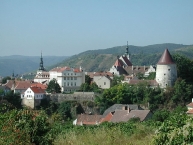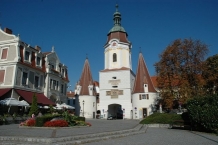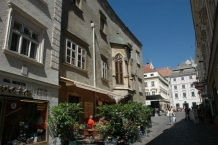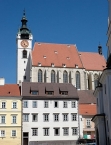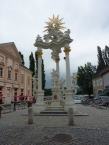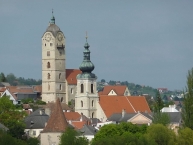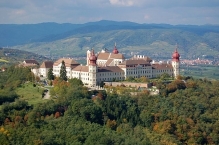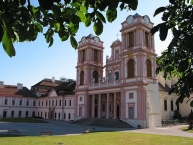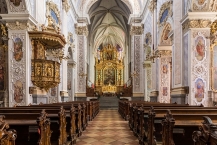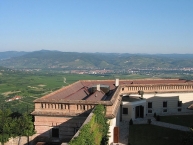Kamp-Thaya-March Radweg
Nr. des Radweges 8
Aktionen
![]()
Bitte warten - Kartendaten werden geladen
Erstellt am 18.01.2012,
zuletzt geändert von biroto-Redaktion am 26.10.2023
Aktionen
Strecken-Merkmale
Gesamtlänge in km
421
Informationen zu Rechten an den GPS-Track-Daten | |
|---|---|
Rechte-Inhaber | OpenStreetMap and Contributors + biroto-Redaktion (biroto.eu) |
Rechte-Ausprägung / Lizenz | Enthält Daten von OpenStreetMap, die hier unter der Open Database License(ODbL) verfügbar gemacht werden |
Link zur Rechtebeschreibung | |
gpx-Datei übernommen aus | |
gpx-Datei hochgeladen | durch biroto-Redaktion am 26.10.2023
|
Gesamtzahl Trackpoints
6.960
Trackpoint-Dichte per km
17
Endorte
Start
Krems an der Donau, NÖ, AT (198 m NHN)
Ziel
Engelhartstetten, NÖ, AT (145 m NHN)
Wegweisung
|
|
Fahrradfreundliche Unterkünfte, Sehenswertes und Infrastruktur
Name u. Anschrift
Breite / Länge
Tel.
Fax.
Mobile
Art d. Unterkunft
Radler-freund-lichkeit
Strecken-km
km zur Strecke
Höhe
0 km
0,4 km
207 m
Informationen zu Urheber-Rechten | |
|---|---|
Rechte-Inhaber | |
Rechte-Ausprägung / Lizenz | by-sa: CREATIVE COMMONS Namensnennung, Weitergabe unter gleichen Bedingungen |
Link zur Rechtebeschreibung | |
Bild übernommen aus | https://commons.wikimedia.org/wiki/File:Blick_auf_die_Altstadt_von_Krems.jpg |
Bild hochgeladen | durch biroto-Redaktion am 13.01.2015
|
Informationen zu Urheber-Rechten | |
|---|---|
Rechte-Inhaber | |
Rechte-Ausprägung / Lizenz | by-sa: CREATIVE COMMONS Namensnennung, Weitergabe unter gleichen Bedingungen |
Link zur Rechtebeschreibung | |
Bild übernommen aus | |
Bild hochgeladen | durch biroto-Redaktion am 13.01.2015
|
Informationen zu Urheber-Rechten | |
|---|---|
Rechte-Inhaber | |
Rechte-Ausprägung / Lizenz | by-sa: CREATIVE COMMONS Namensnennung, Weitergabe unter gleichen Bedingungen |
Link zur Rechtebeschreibung | |
Bild übernommen aus | |
Bild hochgeladen | durch biroto-Redaktion am 13.01.2015
|
Informationen zu Urheber-Rechten | |
|---|---|
Rechte-Inhaber | |
Rechte-Ausprägung / Lizenz | by-sa: CREATIVE COMMONS Namensnennung, Weitergabe unter gleichen Bedingungen |
Link zur Rechtebeschreibung | |
Bild übernommen aus | https://commons.wikimedia.org/wiki/File:Piaristenkirche_Krems.jpg |
Bild hochgeladen | durch biroto-Redaktion am 13.01.2015
|
Krems ist mit 24.085 Einwohnern (2014) die fünftgrößte Stadt Niederösterreich.
Hintergrund
Die Stadt blickt auf eine mehr als tausendjährige Geschichte zurück. So gibt es Zeichen einer germanischen und slawischen Besiedlung aus vorrömischer Zeit. Die erste urkundliche Erwähnung als Urbs Cremisia datiert auf das Jahr 995 n. Chr. Ab dem Jahr 1000 siedelten zunehmend Kaufleute und Händler, so dass die Stadt zunehmend an Bedeutung gewann. Ihre Lage am Handelsweg Donau ließ sie zu einem der bedeutendsten mittelalterlichen Handelsplätze an der Donau werden. Insbesondere der Salzhandel blühte. Im Jahr 1305 wird Krems-Stein das Stadtrecht verliehen. Das noch heute gültige Stadtwappen wird ihr am 1. April 1463 durch Kaiser Friedrich der III. verliehen. Es zeigt den rot-bezüngten goldenen Doppeladler mit der über den Häuptern schwebenden Kaiserkrone auf schwarzem Grund.
Sehenswürdigkeiten
Die Altstadt von Krems gehört zum UNESCO-Welterbe Kulturlandschaft Wachau , das im Jahr 2000 anerkannt wurde. Es ist ein geschlossener Altstadtbestand vorhanden.
Historische Gebäude
- ⊙Bürgerspitalkirche
: Die Kirche wurde 1470 unter Friedrich III. erbaut und liegt an der Oberen Landstraße im Zentrum von Krems. Der Hochaltar stammt von 1860/82, geschaffen von Johann Bernhard Grabenberger mit den Statuen der Heiligen Nikolaus und Wolfgang von Matthias Schwanthaler.
- ⊙Dominikanerkirche und -kloster: 1236 wurde den Dominikanern in Krems ein Bauplatz geschenkt, kurz danach der Bau begonnen. Das Kloster wurde später barock ausgestaltet und 1785 aufgehoben. Heute ist dort das museumkrems
untergebracht.
- ⊙Göglhaus
: Das Haus mit einzigartigen Wandmalereien am Täglichen Markt hat über dem Hauptportal einen gotischen Kapellenerker.
- ⊙Gozzoburg: Frühgotisches Profangebäude mit bemerkenswerten Fresken und Kapellen, nach dem Stadtrichter Gozzo benannt. Als Wohnsitz und Kommunalgebäude ist dieses Gebäude für seine Zeit einzigartig nördlich der Alpen. 2006/2007 generalsaniert.
- Großes Sgraffitohaus: in der Margarethenstraße, bildreiche Fassade, zeigt Szenen aus dem Alten Testament, den Äsopschen Fabeln und Alltags-Szenen.
- ⊙Heilandskirche
errichtet 1912, ein Frühwerk des Architekten Otto Bartning.
- ⊙Jesuitenkollegium- und -gymnasium: 1616 gegründet, 1871 Staatsgymnasium, heute Sitz des Piaristengymnasium Krems und der IMC-Fachhochschule Krems.
- Jüdischer Friedhof
: an der Wienerstraße im Osten der Stadt gelegen; der letzte von insgesamt drei jüdischen Friedhöfen. In Krems gab es bis zur Vertreibung 1421 eine sehr bedeutende Judengemeinde. Danach siedelten sich erst wieder im 19. Jahrhundert Juden in Krems an.
- ⊙Piaristenkirche: Im 11. Jahrhundert erstmals erwähnt, im 16. Jahrhundert großteils neu errichtet. Gilt als „kleine Schwester des Wiener Stephansdomes“. Die barocke Innenausstattung enthält eine große Anzahl von Werken des bedeutenden Malers des österreichischen Barocks, Martin Johann Schmidt, genannt Kremser Schmidt. Daran angebaut ist der Frauenbergturm: Stadtturm, früher Sitz des Türmers, des Feuerwächters.
- ⊙Pulverturm
: Der Turm wurde 1477 erbaut, er diente später als Batterieturm, Teil der Stadtbefestigung.
- ⊙Rathaus
: Markanter Bau in der Oberen Landstraße hin zum Pfarrplatz aus der Mitte des 16. Jahrhunderts. Die barock gegliederte Fassade trägt an der Südwestecke einen markanten Erker aus 1548. 1549 erhielt das Rathaus eine zweischiffige Halle, die von der Nordseite, vom Pfarrplatz aus zu erreichen ist.
- ⊙Stadtpfarrkirche: Geht zurück auf eine Schenkung eines Bauplatzes durch Kaiser Heinrichs II. von 1014. An den Vorgängerbau des frühen 12. Jahrhunderts, eine romanische Basilika mit niedrigem Turm erinnert der Unterbau des Turmes an der Südseite. Erst 1178 wurde der Heilige Veit (Vitus) als Titelheiliger der Kirche genannt. Im Zuge der Gegenreformation wurde der Neubau der Pfarrkirche eines der Symbole des Sieges der Katholiken. Die heutige Inneneinrichtung stammt aus dem 18. Jahrhundert. Martin Johann Schmidt schuf die fünf Deckenfresken
- ⊙Steinertor
: Das Tor ist als einziges von vier Stadttoren erhalten geblieben. Es enthält viele Inschriften und Bilder, wie A.E.I.O.U. (Kaiser Friedrichs III.), Doppeladler mit dem Buchstaben M(aria). T(heresia), rot-weiß-roter Bindenschild und der Steirische Panther bildeten das Wappen der Stadt von 1453–1463, Doppeladler gekrönt mit der Kaiserkrone in den Farben schwarz-gold. Es ist das Wahrzeichen der Stadt Krems.
Museen
- ⊙Weinstadtmuseum, Körnermarkt 14, A-3500 Krems, ☎ +43 2732 801567, April bis 4. Juni Mi - So 11:00 bis 18:00 5. Juni bis Oktober täglich 11:00 bis 18:00, Erw. 5 €
Informationen zu Urheber-Rechten | |
|---|---|
Rechte-Ausprägung / Lizenz | by-sa: CREATIVE COMMONS Namensnennung, Weitergabe unter gleichen Bedingungen |
Link zur Rechtebeschreibung | |
Text(e) übernommen von: |
|
übernommen / bearbeitet am | 13.01.2015 - 03.04.2022
|
übernommen / bearbeitet durch |
|
0 km
2,8 km
204 m
0 km
2,0 km
203 m
Informationen zu Urheber-Rechten | |
|---|---|
Rechte-Inhaber | |
Rechte-Ausprägung / Lizenz | by: CREATIVE COMMONS Namensnennung |
Link zur Rechtebeschreibung | |
Bild übernommen aus | https://commons.wikimedia.org/wiki/File:Stein_a_d_Donau_Panorama.jpg |
Bild hochgeladen | durch biroto-Redaktion am 13.01.2015
|
Informationen zu Urheber-Rechten | |
|---|---|
Rechte-Inhaber | |
Rechte-Ausprägung / Lizenz | by-sa: CREATIVE COMMONS Namensnennung, Weitergabe unter gleichen Bedingungen |
Link zur Rechtebeschreibung | |
Bild übernommen aus | https://commons.wikimedia.org/wiki/File:Stein_Rathausplatz_Johannes_Nepomuk.jpg |
Bild hochgeladen | durch biroto-Redaktion am 13.01.2015
|
Informationen zu Urheber-Rechten | |
|---|---|
Rechte-Inhaber | |
Rechte-Ausprägung / Lizenz | by-sa: CREATIVE COMMONS Namensnennung, Weitergabe unter gleichen Bedingungen |
Link zur Rechtebeschreibung | |
Bild übernommen aus | |
Bild hochgeladen | durch biroto-Redaktion am 13.01.2015
|
Informationen zu Urheber-Rechten | |
|---|---|
Rechte-Inhaber | |
Rechte-Ausprägung / Lizenz | by-sa: CREATIVE COMMONS Namensnennung, Weitergabe unter gleichen Bedingungen |
Link zur Rechtebeschreibung | |
Bild übernommen aus | |
Bild hochgeladen | durch biroto-Redaktion am 13.01.2015
|
Stein an der Donau ist ein Stadtteil von Krems an der Donau . Jahrhundertelang war es eine eigene Stadt und wurde erst 1938 an Krems angeschlossen. Ebenso wie die Innenstadt von Krems gehört auch die Innenstadt von Stein an der Donau zum UNESCO-Weltkultur- und -naturerbe Wachau.
Stein
- ⊙Ehemalige Frauenbergkirche
: gotischer Bau des 14. Jahrhunderts, nach Restaurierung 1963–1965 als Denkmal der Gefallenen der beiden Weltkriege gewidmet.
- ⊙Göttweigerhofkapelle: Kapelle des ehemaligen Wirtschaftshofs des Benediktinerstiftes Göttweig mit Kapelle und gotischen Fresken, datiert um 1300.
- ⊙Großer Passauerhof: Erstmals 1263 genannt, Zehenthof des Bischofs von Passau, Bau in heutiger Erscheinung zwischen 1550 und 1600 aus drei Einzelhäusern zusammengefasst.
- ⊙Haus der Regionen
, das ehemalige Gasthaus Zum Goldenen Elephanten, Steiner Donaulände, 1721 erstmals schriftlich belegt.
- ⊙Kremser Tor: Östlicher Abschluss der mittelalterlichen Stadtbefestigung zur Stadt Krems hin. Erbaut um 1470.
- ⊙Linzer Tor: 1477 erbaut (Tafel mit gotischen Ziffern an der Außenseite eingemauert), im 18. Jahrhundert verändert.
- ⊙Mauthaus: Beeindruckende Freskendekorierung aus der Renaissance, dürfte das Wohnhaus des Brückenmautners gewesen sein, nicht aber das Mauthaus selbst. Dieses befand sich außerhalb des Linzertores im Westen der Stadt.
- ⊙Mazettihaus: Schürerplatz; benannt nach seinem Erbauer; war Wohnhaus Ludwig Ritter von Köchels (geb. 1800 in Stein), des Verfassers des Mozartverzeichnisses.
- ⊙Ehemalige Minoritenkirche: 1264 geweiht, heute Veranstaltungsraum Klangraum Krems und Museen (Forum Frohner, Ernst Krenek Forum, Kunstraum Stein) im anliegenden Klostergebäude.
- ⊙Pfarrkirche Hl. Nikolaus: Spätgotisch, datiert Ende 14./Ende 15. Jahrhundert, enthält mehrere Werke des Kremsers Schmidt.
- ⊙Salzstadl: Salzlagergebäude aus dem 16. Jahrhundert, Stein war auf Grund eines kaiserlichen Privilegs der Umschlagplatz des donauabwärts verschifften bayerischen und Salzburger Salzes für die Länder des nördlichen Mitteleuropas wie etwa Böhmen, Mähren, Schlesien usw.
- ⊙Steiner Rathaus: ab 1701 als Rathaus der Stadt Stein genutzt, Fassade aus 1779 von Johann Michael Ehmann.
Museen
- ⊙Karikaturmuseum, Steiner Landstraße 3a, A-3500 Krems-Stein, ☎ +43 2732 908020
- ⊙Kunsthalle, Franz-Zeller-Platz 3. 3500 Krems
Informationen zu Urheber-Rechten | |
|---|---|
Rechte-Ausprägung / Lizenz | by-sa: CREATIVE COMMONS Namensnennung, Weitergabe unter gleichen Bedingungen |
Link zur Rechtebeschreibung | |
Text(e) übernommen von: |
|
übernommen / bearbeitet am | 13.01.2015 - 28.09.2016
|
übernommen / bearbeitet durch |
|
0 km
4,8 km
424 m
Informationen zu Urheber-Rechten | |
|---|---|
Rechte-Inhaber | |
Rechte-Ausprägung / Lizenz | by-sa: CREATIVE COMMONS Namensnennung, Weitergabe unter gleichen Bedingungen |
Link zur Rechtebeschreibung | |
Bild übernommen aus | https://commons.wikimedia.org/wiki/File:Benediktinerstift_Göttweig,_Luftbild_1.JPG |
Bild hochgeladen | durch biroto-Redaktion am 28.09.2016
|
Informationen zu Urheber-Rechten | |
|---|---|
Rechte-Inhaber | |
Rechte-Ausprägung / Lizenz | by-sa: CREATIVE COMMONS Namensnennung, Weitergabe unter gleichen Bedingungen |
Link zur Rechtebeschreibung | |
Bild übernommen aus | |
Bild hochgeladen | durch biroto-Redaktion am 28.09.2016
|
Informationen zu Urheber-Rechten | |
|---|---|
Rechte-Inhaber | |
Rechte-Ausprägung / Lizenz | by-sa: CREATIVE COMMONS Namensnennung, Weitergabe unter gleichen Bedingungen |
Link zur Rechtebeschreibung | |
Bild übernommen aus | https://commons.wikimedia.org/wiki/File:Stiftskirche_Göttweig_Innenraum_03.JPG |
Bild hochgeladen | durch biroto-Redaktion am 28.09.2016
|
Informationen zu Urheber-Rechten | |
|---|---|
Rechte-Inhaber | |
Rechte-Ausprägung / Lizenz | by-sa: CREATIVE COMMONS Namensnennung, Weitergabe unter gleichen Bedingungen |
Link zur Rechtebeschreibung | |
Bild übernommen aus | |
Bild hochgeladen | durch biroto-Redaktion am 28.09.2016
|
Das Stift Göttweig ist eine barocke Klosteranlage auf dem Göttweiger Berg in der Gemeinde Furth, wenige Kilometer südlich von Krems an der Donau (Niederösterreich).
Hintergrund
1083 wurde das Kloster als Augustiner-Chorherrenstift gegründet, aber 1094 den Benediktinern übergeben. Die ursprüngliche Anlage wurde 1580 durch einen Brand zerstört, aber wieder aufgebaut. Nach einem neuerlichen Brand 1718 wurde die heutige Anlage 1720 bis 1740 von Johann Lucas von Hildebrand erbaut.
Das Kloster liegt am nordöstlichen Eingang zur Kulturlandschaft Wachau und gehört zum Welterbe der UNESCO.
Sehenswürdigkeiten
Die Stiftskirche weist noch Teile des hochgotischen Chors auf, ein frübarockes Langhaus, aber eine klassizistische Fassade. das Stiegenhaus des Stifts mit Fresko von Paul Troger zählt zu den bedeutendsten Werken des Barock.
Weiter sind die Krypta und die Kunstsammlungen mit graphischem Kabinett im Kaisertrakt des Stifts sehenswert.
Von der Restaurantterasse genießt man einen großartigen Ausblick auf Krems und das Donautal mit der Wachau, im Osten bis zum Wienerwald.
Informationen zu Urheber-Rechten | |
|---|---|
Rechte-Ausprägung / Lizenz | by-sa: CREATIVE COMMONS Namensnennung, Weitergabe unter gleichen Bedingungen |
Link zur Rechtebeschreibung | |
Text(e) übernommen von: |
Wikivoyage-Bearbeiter, 'Göttweig', Wikivoyage, Freie Reiseinformationen rund um die Welt, 15. August 2016, 06:32 UTC, <https://de.wikivoyage.org/w/index.php?title=G%C3%B6ttweig&oldid=948478> [abgerufen am 28. September 2016] |
übernommen / bearbeitet am | 28.09.2016
|
übernommen / bearbeitet durch |
|
Öffnungszeiten
Museum
19. März bis 1. November 2016:
BESICHTIGUNG ohne Führung: täglich von 10-18 Uhr (Juni bis September 9-18 Uhr)
Kassaschluss und letzter Einlass: 17 Uhr
Pforte & Klosterladen
Ab 19. März bis 26. Dezember 2016:
täglich 08:00 - 18:00 Uhr
0 km
2,9 km
203 m
![]()


